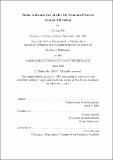| dc.contributor.advisor | George Lusztig. | en_US |
| dc.contributor.author | He, Xuhua, 1979- | en_US |
| dc.contributor.other | Massachusetts Institute of Technology. Dept. of Mathematics. | en_US |
| dc.date.accessioned | 2007-08-03T19:33:19Z | |
| dc.date.available | 2007-08-03T19:33:19Z | |
| dc.date.copyright | 2005 | en_US |
| dc.date.issued | 2005 | en_US |
| dc.identifier.uri | http://hdl.handle.net/1721.1/38452 | |
| dc.description | Thesis (Ph. D.)--Massachusetts Institute of Technology, Dept. of Mathematics, 2005. | en_US |
| dc.description | Includes bibliographical references (p. 101-103). | en_US |
| dc.description.abstract | This thesis is concerned with the intrinsic structure of the De Concini-Procesi compactification of semi-simple adjoint algebraic groups and some relations with other topics of algebraic groups. In chapter 1, we study the closure of the totally positive part of an adjoint group in the group compactification. One result that we obtain is the positive property of the closure with respect to the canonical basis. In addition, we get an explicit description of the closure. As a consequence of the explicit description, the closure admits a cellular decomposition, which was first conjectured by Lusztig. In chapter 2, we give a new proof of the parametrization of the totally positive part of ag variety which was first proved by Marsh and Rietsch using the generalized Chamber Ansatz. My proof is based on the theory of canonical basis. The remaining chapters are related to the pieces of the group compactification introduced by Lusztig in the paper "Parabolic character sheaves II". In chapter 3, we study the closure of the unipotent variety in the group compactification, following the previous work of Lusztig and Springer. We show that the closure of the unipotent variety is the union of the unipotent variety itself together with finitely many pieces. By the same method, we also prove a similar result for the closure of arbitrary Steinberg fiber. In chapter 4, we study the closure of any piece in the group compactification. We show that the closure is a union of some other pieces. We will also discuss the existence of cellular decomposition. Chapter 1, 3 and 4 of this thesis are roughly based on the papers [H1], [H2] and [H3], in that order. Chapter 2 is based on an unpublished result. Each chapter can be read independently of the others. | en_US |
| dc.description.statementofresponsibility | by Xuhua He. | en_US |
| dc.format.extent | 103 p. | en_US |
| dc.language.iso | eng | en_US |
| dc.publisher | Massachusetts Institute of Technology | en_US |
| dc.rights | M.I.T. theses are protected by copyright. They may be viewed from this source for any purpose, but reproduction or distribution in any format is prohibited without written permission. See provided URL for inquiries about permission. | en_US |
| dc.rights.uri | http://dspace.mit.edu/handle/1721.1/7582 | |
| dc.subject | Mathematics. | en_US |
| dc.title | Some subvarieties of the De Concini-Procesi compactification | en_US |
| dc.type | Thesis | en_US |
| dc.description.degree | Ph.D. | en_US |
| dc.contributor.department | Massachusetts Institute of Technology. Department of Mathematics | |
| dc.identifier.oclc | 61215071 | en_US |
